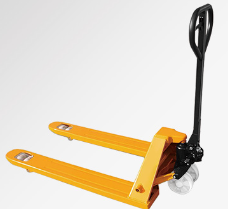News Details
Working principle of manual hydraulic transport vehicle
Manual hydraulic transport vehicle is a dual-purpose vehicle for high lift loading and short distance transportation. Based on the design advantages of no sparks and electromagnetic fields, it is generally suitable for the loading and unloading of automobiles, as well as the loading and transportation of flammable, explosive, and prohibited materials in workshops, warehouses, docks, stations, freight yards, and other places. This product has the characteristics of lifting balance, flexible rotation, and convenient operation.
The manual hydraulic transport vehicle is lightweight and easy to operate. Use an electromechanical integrated hydraulic station. High strength steel fork structure, safe, reliable, and durable. Low price, economical and practical.

The principle of a manual hydraulic transport vehicle is that hydraulic oil is formed by a blade pump to a certain pressure, which enters the lower end of the hydraulic cylinder through an oil filter, explosion-proof electromagnetic directional valve, throttle valve, hydraulic control one-way valve, and balance valve, causing the piston of the hydraulic cylinder to move upwards and lift heavy objects. The return oil from the upper end of the hydraulic cylinder returns to the oil tank through the explosion-proof electromagnetic directional valve, and its rated pressure is adjusted through the relief valve. The pressure reading on the pressure gauge is observed.
The piston of the hydraulic cylinder moves downwards (i.e. the weight is lowered). Hydraulic oil enters the upper end of the hydraulic cylinder through an explosion-proof electromagnetic directional valve, and the return oil from the lower end of the hydraulic cylinder returns to the oil tank through a balance valve, hydraulic control one-way valve, throttle valve, and explosion-proof electromagnetic directional valve. In order to ensure stable descent of heavy objects and safe and reliable braking, a balance valve is installed on the return oil circuit to balance the circuit and maintain pressure, so that the descent speed is not affected by heavy objects. The flow rate is adjusted by the throttle valve to control the lifting speed. To ensure safe and reliable braking and prevent accidents, a hydraulic control one-way valve, also known as a hydraulic lock, is added to ensure safe self-locking in the event of an accidental rupture of the hydraulic pipeline. An overload sound control alarm has been installed to distinguish between overloading or equipment failure.

